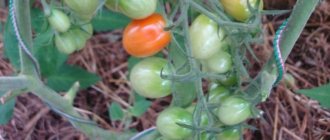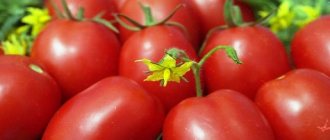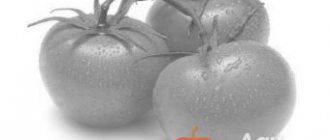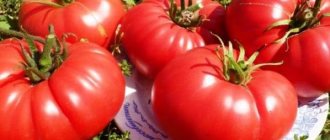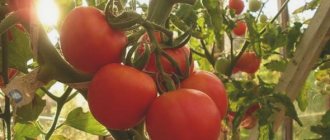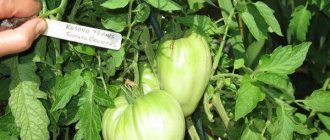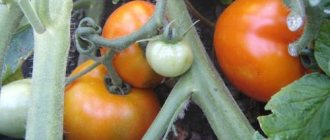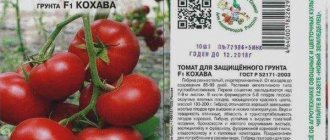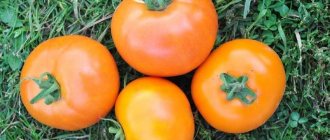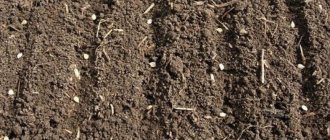Description of the hybrid
Dutch hybrid Polonaise f1 is a product of selection by Bejo Zaden. Included in the State Register of Selective Achievements of the Russian Federation in 2010. The plant is determinate, with a powerful root system and thick stems.
In the photo - tomatoes Polonaise f1.
Distinctive features
The table summarizes the main characteristics of the Polonaise hybrid.
| Indicators | Characteristic |
| Weight | 150–200 g |
| Form | Flat-round, medium ribbed |
| Coloring | Red, without green spot at the stalk |
| Leaves | Medium size, green |
| Type of inflorescences | Simple |
| Number of slots | From 4 to 6 |
| Pulp | Medium density with 4–6 chambers |
| Taste | Sweet, with pleasant sourness |
| Skin | Medium density, easily leaves the pulp |
| Purpose | For fresh consumption |
| Bush height | 80 cm in the garden, up to 1 m in the greenhouse |
| Ripening period | 62–65 days |
| Productivity | 4–6 kg/m² |
| Sustainability | To verticillium and fusarium wilt, tobacco mosaic virus |
| Transportability | High |
Growing and care
The Polonaise tomato variety is grown using purchased seedlings. Seeds collected from the garden are unlikely to sprout, since they are a hybrid. To avoid this situation, you should purchase seeds in special departments or order them from an online store.
- Seeds are planted in pre-prepared containers. The soil should be enriched with humus. A depth of 1.5 cm is sufficient. The planted seeds are moistened and the containers are covered with film. When two leaves appear, a pick is made.
- When planting in a permanent place of growth, it is necessary to maintain a distance between plants. 1 m2 can accommodate 3 plants, no more.
- Tomatoes require moderate watering and lighting. Watering is best done in the morning or evening. Be sure to loosen the soil so that the roots can “breathe.” Removing weeds will also help the plants form properly.
- Application of complex fertilizers is necessary several times per season. The first feeding is carried out after planting, the rest - during flowering and budding.
The Polonaise tomato variety is an excellent choice for a beginning vegetable grower and an experienced vegetable grower. It has a pleasant sweet and sour taste. Suitable for fresh consumption, for freshly squeezed juices. In addition, it can be used for canning. The vegetable makes excellent tomato paste and sauces. Try growing this variety and taste the delicious fruits!
Pink Solution tomato - description and characteristics of the variety
Growing seedlings
Polonaise tomatoes are among the ultra-early ripening tomatoes. Sowing of seedlings is carried out in March, two months before transferring to the ground
Preparing seeds and soil for sowing
Hybrid seeds are disinfected in production, so they do not need to be soaked in disinfecting compounds. In addition, the seed material is distinguished by its rapid germination rate.
The soil for sowing seeds is prepared independently from black soil, peat, humus, mixed in equal quantities. Then add 20 g of superphosphate and wood ash for every 10 kg. Ready-made soil mixture for tomatoes from stores is also suitable. It already contains all the necessary nutrients.
The soil is calcined in advance in a microwave, oven, or poured with a strong solution of potassium permanganate.
The seedling boxes are filled with moist soil and furrows of 1.5 cm are made. The seeds are laid out at a distance of 2 cm and sprinkled with a layer of soil on top. Water with warm water using a syringe or sprayer and cover with film or glass to create a greenhouse effect.
Shoots appear at an air temperature of +25 °C in 4-5 days. The soil is ventilated daily for 15–20 minutes to prevent mold from appearing.
Seedling care
After the sprouts appear, the boxes are taken to a well-lit place, the film or glass is removed. To prevent seedlings from stretching upward when there is a lack of sunlight, phytolamps are placed nearby.
The seedlings are watered as the top layer of soil dries.
Picking into individual containers made of peat or plastic is done after 2-3 true leaves appear.
Thanks to the efforts of biologists, Polonaise tomato seedlings grow strong without the need for additional fertilizing.
Advice . A week before planting seedlings in the ground, take the containers out into fresh air to harden for 15–30 minutes.
Description and characteristics of the variety
The variety was obtained by breeders from Holland. The ideal conditions for growing are those in the south of Russia. In other regions, Polonaise tomatoes can be grown exclusively indoors.
Mature plants have erect stems, they are powerful, strong, strong. In open ground they reach a height of up to 85 cm, and in greenhouse conditions they can reach greater heights - up to 1 meter. Since the plants are of a determinate type, pinching is not carried out, and tying to supports is necessary only in greenhouse conditions.
The fruits of the Polonaise tomato are round, smooth, even, with a matte surface. There is no ribbing. Ripe tomatoes have a bright red color. The peel is dense and can be easily removed if necessary.
The weight of a ripe tomato reaches 200 grams. Inside there are from 4 to 6 chambers with seeds. The taste is simply excellent. Thanks to this, the fruits are good for individual cuts and salads. Suitable for canning, creating sauces and pastes.
The variety is considered ultra, that is, very early. So, from the time the first shoots appear until the tomatoes appear, no more than 2.5 months pass. The yield is high: up to 5 kg are harvested from one adult bush, and in a greenhouse the yield reaches even 8 kg!
The variety has excellent immunity, like many other hybrids. It is not afraid of any diseases characteristic of vegetable crops, as well as pests.
tomato Pink Clear F1 - description and characteristics of the variety
All cultures have their own distinctive characteristics. Very early tomato varieties are characterized by the following positive qualities:
- The main problem of all garden crops is diseases. Tomatoes are most often affected by late blight. This disease is very difficult to fight. The source of infection is fungal spores, which begin to develop intensively on the plant during strong fluctuations in night and day temperatures, as well as in air saturated with moisture. This usually begins towards the end of summer and beginning of autumn, when all the super-early varieties have time to produce the entire harvest.
- For some reason, many vegetable growers think that early tomato varieties will have small stems. Actually this is not true. For example, the bush of the “Explosion” variety is only 45 cm in height, and the stem of the hybrid “Blagovest F1” grows to 2 m or more.
- The fruits of all varieties of tomatoes differ in their taste. Ultra-early tomatoes ripen in the sun on the most favorable summer days, so they are tastier than the fruits produced by late varieties. The pulp of the early vegetable is always sweet and endowed with a subtle aroma. Such fruits should be eaten immediately or juiced. They are not good for canning.
- Many super early varieties cannot boast large fruits. Typically, the weight of the largest tomatoes reaches 200 g, and the small ones - 50 g. However, there are exceptions. For example, the “Big Momma” variety produces tomatoes weighing 400 g.
- The main characteristic of ultra-early crops is high yield. Depending on the variety, the amount of harvest varies from 7–15 kg/m2.
READ MORE: Tomatoes for the winter - 634 step-by-step cooking recipes
These are, in principle, all the features of early-ripening tomato varieties that distinguish them from crops of other ripening periods.
Tomato cultivation
The early ripening hybrid Polonaise is easy to grow and care for. The culture loves moderate watering and mineral fertilizing. It is characterized by resistance to most nightshade viral diseases.
Landing
Transferring seedlings to open and closed ground begins in May. The timing depends on the growing region. In the southern regions, tomato bushes are planted after the soil warms up to +15 °C (in the second or third decade). In northern latitudes, tomatoes are grown only in greenhouses, so planting is done in early May.
No more than three bushes are placed per 1 m². Holes for seedlings are dug to a depth of 20 cm and disinfected with a hot solution of potassium permanganate. The seedlings are watered abundantly with warm water and rolled along with the earthen lump.
The beds are sprinkled with mulch - peat, sawdust or hay. This allows you to retain moisture in the soil and prevent the growth of weeds.
Care
Five days after planting, the first watering is carried out with settled or rainwater. Then the soil is moistened once a week at the rate of 5 liters of water per 1 m².
Weeding and loosening are carried out without fail after watering.
During the short growing season, tomatoes are fertilized three times:
- The first portion is nitrogen fertilizers two weeks after planting: 40 g of nitrophoska, 20 chicken manure per 1 liter of water, then increase the volume to 10 liters.
- The second portion is potassium-phosphorus feeding 10 days after the first: take 10 g of superphosphate, 20 g of chicken manure per 1 liter of water, and bring the volume to 10 liters. Consumption – 5 l/m².
- The third portion is potassium-phosphorus fertilizer (20 g of superphosphate, 40 g of ash per 10 liters of water) two weeks after the second feeding. Consumption – 5 l/m².
Features of cultivation
A distinctive feature of the Polonaise hybrid is its adaptability to cultivation in the southern regions in the open air. A large amount of green mass protects the fruits from direct sunlight. Plant life processes are less active compared to varieties and hybrids intended for northern regions. At the same time, southern tomatoes are better adapted to changes in weather conditions.
Important ! For comparison: “northern” tomatoes are not suitable for growing in open ground in the southern regions due to the small amount of greenery. They quickly burn out under the scorching rays and cannot provide the fruits with the necessary nutrition.
Hybrid Polonaise can be grown in greenhouses in the middle and northern zones. The ovaries on the bushes are formed simultaneously even at low temperatures, which ensures a friendly harvest.
Tomato Polonaise F1. Hybrid characteristics
Diseases and pests
Tomatoes are resistant to verticillium wilt, fusarium wilt, and tobacco mosaic virus.
Thanks to early ripening, there is no time to become infected with late blight, but prevention will not hurt, since the bushes bear fruit until the end of August. To do this, greenhouses are fumigated with sulfur bombs, the soil in the garden is treated with copper sulfate and mulched with sawdust, pine needles, hay or peat.
The disease can be recognized by brown spots with a gray tint on leaves, stems, fruits, and a white coating on the back of the leaves. The products “Fitosporin”, “Ridomil Gold”, “Quadris”, “Baktofit” will help you quickly get rid of late blight.
To combat spider mites, aphids, and whiteflies, the preparations Fitoverm, Flumite, Epin, and Zircon are used.
In the fight against insects, folk remedies are no less effective:
- 100 g of dried chamomile flowers are poured into 1 liter of warm water and left for 10 hours. Then bring the volume to 5 liters and add 15 ml of liquid soap. Spray the bushes once a week.
- Dilute 125 g of liquid soap in 10 liters of water and irrigate the plants once a week.
- Add 3 kg of ash to 10 liters of hot water and leave for two days. Strain through cheesecloth and add 50 g of grated soap. Treatment is carried out after sunset once every 7 days.
- Dissolve 10 tbsp in 10 liters of water. l. soda and spray the greens twice a week.
- Add 1 ml of iodine and 1 liter of water to 200 ml of milk. Used to treat bushes twice a week.
Advantages of a hybrid
The characteristics of the tomato indicate the possibility of cultivation in the southern regions. A distinctive feature of such hybrids is a large amount of strong foliage, which protects the ovaries from excess sunlight.
Hybrids intended for the southern regions, due to the fact that the warm season lasts 4.5-5 months, differ in the period of fruit ripening. Varieties adapted for cultivation in northern regions quickly increase their vegetative mass. Ovaries are formed on the bushes, ensuring almost simultaneous yield of the crop.
Despite the growth rate of the variety, the fruits cannot be cultivated in the southern regions. Ripening tomatoes can get burned and lose their taste and appearance.
The Polonaise tomato variety belongs to the selection of Dutch specialists. During the growing season, the bush reaches a height of 0.8-0.85 cm. The stems do not require formation or pinching. In closed ground conditions, tomatoes reach 1 m in height and require gartering to trellises or stakes.
The erect stems of the variety are strong and can withstand the load of fruit.
- Ripe tomatoes, as seen in the photo, are round in shape, with a smooth surface, without ribbing, and bright red in color.
- The skin of the fruit is thin and easily separated from the pulp.
- When cut horizontally, the presence of 4-6 seed chambers is observed.
- The average fruit weight is 200 g.
- Due to their excellent taste, tomatoes can be canned and used fresh.
The Polonaise tomato, the description of which is associated with the early period of fruit ripening (2.5 months), is characterized by high yield. From 1 bush you can remove about 5 kg of fruit, and when cultivated indoors - 7-8 kg.
The main valuable quality of the variety is resistance to major diseases that affect tomatoes.
The nuances of growing in open ground and in a greenhouse
Tomatoes in a greenhouse need fresh air and optimal temperature for successful growth . To ensure comfortable conditions, 2 hours after watering, the doors and vents in the heifer are opened for ventilation for 30–60 minutes. In hot weather, the windows should be constantly open. The optimal temperature during the day is +22 °C, at night +16 °C.
In greenhouses, bushes are tied to supports, since in such conditions they grow 20–30 cm higher.
Polonaise tomatoes do not require pinching or staking when grown in open ground. The plant has a strong root system and thick stems that can support the weight of the fruit.
Early ripening varieties of determinate tomatoes
Many new early-ripening varieties of tomatoes, which are first-generation hybrids and suitable for greenhouses and open ground, are offered annually by Holland. Some of them produce good yields when grown in open ground, even in the northern regions of the Russian Federation.
Important! The growing season for Dutch tomato hybrids is indicated from the day the seedlings are planted.
Variety "Townsville F1"
A powerful determinate bush that produces medium-sized, round tomatoes weighing up to 200 g. When ripe, the tomatoes are red in color with excellent taste. Can be stored for up to three weeks.
The height of the tomato bush reaches 1.2 m. The variety is high-yielding, so the bush requires a garter. Branching and foliage are average. The variety is recommended for cultivation throughout almost all of Russia, including the Urals and Siberia. In the southern regions it can grow in open ground, in the north it needs greenhouse conditions.
The growing season is 67 days. Up to 9 kg of tomatoes are harvested from 1 m². Resistant to pathogenic factors.
Agricultural technology
Attention! Seeds from Dutch companies have already been processed and do not need soaking.
The seeds of the hybrid are sown in March, covered with film and placed in a warm place. The film is removed after seed germination and the tomato seedlings are moved to a well-lit place, maintaining the temperature at 17°C for a week. Later it is increased to +22. Forty-day-old seedlings are planted in a permanent place.
Variety "Polonaise F1"
New early determinate hybrid. The tomato bush is very powerful. It is recommended to plant at the rate of 3 bushes per square meter. Suitable for cultivation in the south of Russia. When grown outdoors, the variety produces good ovaries.
Tomatoes weighing up to 220 g. They ripen 65 days after planting the seedlings. A ripe tomato is uniformly red in color without a green spot at the stem. The pulp is dense. Has good taste.
The variety is resistant to major diseases and has good transportability.
Variety "Polbig F1"
The fastest ripening of the Dutch determinate hybrids. The harvest can be harvested after 58 days.
The height of the bushes reaches 0.8 m. The tomatoes are round, red, and medium in size. In open ground, the weight of a tomato is up to 130 g, in greenhouses it can grow up to 210. The yield per bush is up to 4 kg at a planting density of 5-6 bushes per unit area.
The purpose of the variety is universal. Can be used as a salad tomato or for processing and preservation.
The variety can be grown in open beds, in greenhouses or film shelters. Relatively cold-resistant, shows good formation of ovaries even at low temperatures.
The advantages of this variety of tomatoes include:
- early ripening of tomatoes, due to which the harvest is harvested before the appearance of late blight;
- resistance of the tomato bush to low temperatures;
- resistance to pathogenic microflora (it simply does not have time to multiply);
- good keeping quality of tomatoes and resistance to cracking;
- high transportability of tomatoes;
- leveled fruits.
Gardeners considered the disadvantages of the need to tie up the stem and fruiting shoots, which can break under the weight of the tomatoes.
Important! The variety shows maximum yield when growing bushes of 2-3 stems.
Variety "Torbay F1"
A mid-early hybrid developed by the Dutch in 2010. Certified in Russia in 2012.
A tomato bush grows up to 85 cm in the open air; in a greenhouse it can be up to 1.5 m high. The growing season is 65 days. Standard variety.
Ripe Torbay tomatoes are pink, round, weighing up to 210 g, sweet and sour in taste.
Advantages of the variety:
- friendly return of the harvest;
- the ability of tomatoes to be stored for a long time;
- high transportability;
- resistance to pathogenic microflora;
- high ability of tomatoes to ripen during storage.
The disadvantage of this variety is the need for increased attention to the bushes at the initial stage of cultivation: fertilizing and loosening the soil.
The yield of the variety is up to 6 kg per bush. Planting density: 4 bushes per unit area.
A variety of universal-purpose tomatoes. Tomatoes are used both as salad tomatoes and for cooking and processing into juices. They are also good for winter preparations.
Features of agricultural technology
The variety grows very well outdoors in the southern regions of Russia, showing the best results in this climate. In the central zone it requires film shelters, and in the northern regions it can only be grown in greenhouse conditions. Greenhouses must be heated.
The Torbay bush requires obligatory gartering and strengthening of branches with supports to prevent them from breaking off. You can form a tomato bush into two stems, but usually it is formed into one to obtain larger tomatoes.
At the initial stage, the variety requires large amounts of phosphorus and potassium. Later it is fed along with other tomatoes.
Features of agricultural technology of Dutch tomato varieties
- Dutch determinate hybrids are intended for industrial cultivation. Of course, they can also be grown in utility plots, but, for example, in a greenhouse, hybrids will show the best results when using hydroponics, which is unlikely to be used by a private owner.
- Hybrids are self-pollinating, but for better results the manufacturer recommends using bumblebees. This is also not very convenient for a private owner.
- Using Dutch agricultural technology, 65 kg of tomatoes are obtained from one square meter. With normal cultivation, accessible to an amateur gardener, 15 kg of tomatoes.
- Proper cultivation of seedlings of hybrid varieties is mandatory: a mixture of peat and sand is used for sowing, and seedling cassettes equipped with drainage are placed in a well-lit place with optimal temperature and humidity.
Among Russian companies, perhaps the earliest varieties of tomatoes are offered by Siberian producers. At least the bulk of varieties of such tomatoes, which is due to the conditions of their breeding.
Variety "Far North"
An early standard variety with a growing season of 90 days. The tomato bush is erect and powerful. Tomatoes are round, up to 80 g. Does not require pinching, adapts well to adverse weather conditions. Even in risky farming areas, this variety can be sown directly into the soil, bypassing the seedling stage. Used in salads and marinades.
Resistant to pathogenic microflora.
Variety "Legionnaire"
Early ripening. The bush is determinate, spreading, weakly leafy. It can be grown in greenhouses and open beds, but tomatoes are zoned for the southern regions. To the north it grows only in greenhouses. The variety is productive. Delivers up to 17 kg/m².
Ripe tomatoes are pink, round, weighing up to 150 g. If they have good taste, they are recommended for fresh consumption.
The advantages include friendly yield and resistance to pathogenic microflora and cracking.
Variety "Parodist"
Early ripening, growing season 85 days. Bushes up to half a meter high. Suitable for greenhouses and open beds, but the cultivation method is slightly different: the variety does not need to be formed in the ground; in greenhouses, tomatoes are grown into three stems.
The variety is included in the State Register as zoned for the North Caucasus and Central Black Earth regions. It is recommended there for cultivation in subsidiary plots.
Relatively frost-resistant, forms ovaries well in almost any natural conditions. Does not suffer from fusarium and cladosporiosis.
Planting scheme for this tomato: up to 6 bushes per square meter. m. Productivity is 3.5 kg per bush, that is, up to 20 kg/m².
Ripe red tomatoes. The shape is round, flattened at the tops. Weight up to 160 g. The taste is good for early ripening tomatoes. They belong to the group of salad tomatoes.
Advantages and disadvantages
Advantages of Polonaise tomatoes:
- amicable maturation;
- formation of ovaries even in cold weather;
- attractive appearance;
- excellent taste;
- 100% seed germination;
- thin skin;
- universal use in cooking;
- bushes do not need pinching or staking in open ground.
The hybrid has few disadvantages:
- plants require staking in greenhouses;
- not suitable for growing in open ground in the middle zone and northern regions.
Differences between southern hybrids
The main feature, the “zest” of hybrids bred for cultivation in the southern parts of the country is the incredible amount of bright green foliage that covers the entire bush. The green “head” protects the tomato fruits from the scorching hot southern sun. In this regard, the harvest of southern hybrids takes a little longer to ripen than their northern “brothers”. 4.5 - 5 months is a suitable period for the south, since summer here lasts much longer. The fruits have time to ripen during the season.
tomato Pink Rise F1 - description and characteristics of the variety
Reviews
Experienced farmers and amateur gardeners share positive reviews about growing the Polonaise hybrid:
Valery, Mineralnye Vody, Stavropol Territory: “These are ideal tomatoes for open ground. The culture pleases with its yield, smooth ripening and ease of care. The tomatoes are almost the same size, with a pleasant taste and bright color.”
Inna, Prikaspiysk, Astrakhan region: “This Dutch hybrid is good for its early ripening and resistance to most diseases. The tomatoes did not even have time to be affected by late blight, although I did not take any preventive measures. Caring for the crop is simple and comes down to moderate watering and fertilizing.”
Nadezhda, Syzran, Samara region: “I’m planting Polonaise tomatoes in a greenhouse. The bushes grow up to 1 m in height, so I tie them to supports. The stems themselves are quite thick and can support the weight of the fruit. There is no need to trim the bushes. The taste of tomatoes is excellent: sweet, with a slight sourness.”
general information
This group of tomatoes includes plants whose fruit ripening period is less than 90-100 days.
Of course, in specific conditions everything will be slightly different, but in general the general characteristics are consistent. Such tomatoes can be divided into:
- ultra-early (ultra-early ripening);
- early ripening (early ripening).
The age of early tomato seedlings for planting in the ground should be 40-50 days. In this case, the deadlines will be different for each region:
- April 10-15 (this is for the south of Ukraine, Krasnodar Territory, and other warm areas);
- May 10-15 (Moscow region, middle zone);
- June 10-15 (Siberia, Ural, North-West region).
The dates are given conditionally, approximate, since much depends on the year, weather, conditions for growing tomatoes (open ground, greenhouse).
It is necessary to take into account all the recommendations indicated by the seed manufacturer on the bag, and also use your own growing experience.
IMPORTANT: Early-ripening tomatoes have certain characteristics when compared with mid-ripening and late-ripening ones:
- The yield of such varieties and hybrids is usually lower than that of their counterparts that ripen later.
- The fruits are not particularly large (although there are exceptions to this rule).
- Short fruiting period.
That is why there should be tomatoes of different ripening periods on the site.
Although early ripening tomatoes have their advantages:
- They are maximally adapted to climate change (and this is always very important).
- They are distinguished by good taste of the fruit.
- They ripen in a short time, which makes it possible to get an early harvest.
- These tomatoes usually have thin skin, so they are not suitable for canning. And they are best suited for fresh consumption, in salads, and for making juices.
- Unpretentious in care.
- Resistant to diseases. Many of these tomatoes manage to harvest before the hated late blight appears, so diseases are not so terrible for early tomatoes.
- Huge selection of varieties and hybrids.

